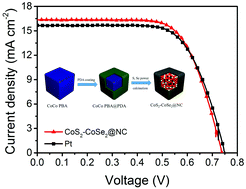Encapsulating CoS2–CoSe2 heterostructured nanocrystals in N-doped carbon nanocubes as highly efficient counter electrodes for dye-sensitized solar cells†
Abstract
Designing low-cost electrocatalysts combining the features of outstanding catalytic activity, excellent electrical conductivity, and high chemical stability remains a critical challenge for the large-scale fabrication of dye-sensitized solar cells (DSSCs). Here we report the controlled synthesis of CoS2–CoSe2 heterostructured nanocrystals encapsulated in N-doped carbon hollow nanocubes (CoS2–CoSe2@NC) through simultaneous sulfurization and selenization of polydopamine coated Prussian blue analogs. Benefiting from both structural and compositional characteristics, namely, the synergistic effect of CoS2–CoSe2 heterojunctions, the conductive N-doped carbon coating and the porous structure of the nanocubes, the resultant CoS2–CoSe2@NC nanocubes exhibit excellent electrocatalytic activity and cycling stability toward the generation of I3− ions in DSSCs. A typical device achieves a high power conversion efficiency (PCE) of 8.45% under AM1.5G illumination (100 mW cm−2), superior to that of a standard Pt-based device (8.07%). These results demonstrate that the as-synthesized CoS2–CoSe2@NC nanocubes are promising alternatives to Pt in DSSCs. The work represented here not only provides a promising strategy to design efficient and robust CE catalysts, but also can be extended for synthesizing other novel metal sulfide/selenide hybrid materials for applications in the fields of energy conversion and storage.



 Please wait while we load your content...
Please wait while we load your content...